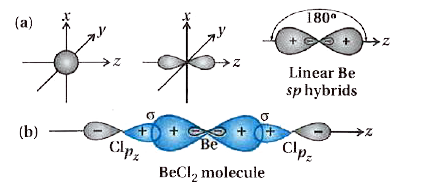Explain the bond formation by sp orbitals. OR Explain the bond formation in BeCl2 explain why BeCl2 is linear.
Text Solution
In BeCl2,Be [He]2s2.And form exited Be⋅[He]2s12p1. The divalency of Be in exited state the one electron arrange in 2s and one in 2p orbit.
One 2s and one 2p orbital of exited Be undergo hybridization and form two sp hybrid orbital.
These two sp hybrid orbitals are oriented in opposite direction formatting an angle of 180∘.
Cl atom [Ne]3s23p2x3p2y3p1z. Every sp orbital overlap with 3pz orbital of chlorine (Cl) with z axis and form two Be - Cl σ bond.

Each of the sp hybridised orbital overlaps with the 2p orbital of chlorine axially and form two Be-Cl sigma bond and BeCl2 form with Linear shape.
|
Topper's Solved these Questions
- CHEMICAL BONDING AND MOLECULAR STRUCTUREBOOK - KUMAR PRAKASHANCHAPTER - CHEMICAL BONDING AND MOLECULAR STRUCTUREEXERCISE - TRY YOUR SELF-3
1 Videos
- CHEMICAL BONDING AND MOLECULAR STRUCTUREBOOK - KUMAR PRAKASHANCHAPTER - CHEMICAL BONDING AND MOLECULAR STRUCTUREEXERCISE - TRY YOUR SELF-4
1 Videos
- CLASSIFICATION OF ELEMENTS AND PERIODICITY IN PROPERTIES BOOK - KUMAR PRAKASHANCHAPTER - CLASSIFICATION OF ELEMENTS AND PERIODICITY IN PROPERTIES EXERCISE - Section -D SOLUTIONS OF NCERT EXEMPLAR PROBLEMS (Long Answer Type Questions )
7 Videos
Similar Questions
Explain the formation of a chemical bond.
View SolutionExplain the formation of a chemical bond.
View SolutionExplain the formation of chemical bond.
View SolutionExplain the formation of chemical bond.
View SolutionExplain the nature of the covalent bond using the bond formation in CH3Cl.
View SolutionExplain the nature of the covalent bond using the bond formation in CH3Cl.
View SolutionExplain the nature of the covalent bond using the bond formation in CH3Cl.
View SolutionExplain the nature of the covalent bond using the bond formation in CH3Cl.
View SolutionExplain the nature of the covalent bond using the bond formation in CH3Cl.
View SolutionExplain the formation of ionic bond with two examples.
View Solution
